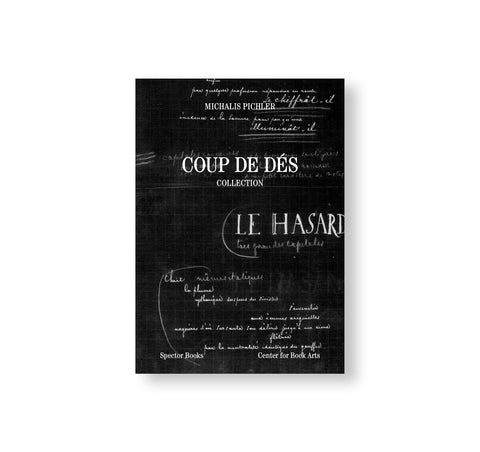GINZA HACCHO / EVERY BUILDING ON THE GINZA STRIP by Michalis Pichler
ドイツを拠点に活動するフォトグラファー、ミハリス・ピヒラー(Michalis Pichler)の作品集。画家・随筆家として名高い木村荘八が1954年に出版した作品集『銀座界隈』の別冊『アルバム・銀座八丁』は、友人の鈴木芳一が銀座の中央通りに面する全ての店舗のファサード写真を撮り、1つにつなぎ合わせたパノラマ写真をアコーディオン装丁するという画期的なものだった。それから12年後、カリフォルニアのアーティスト、エド・ルシェー(Ed Ruscha)が、これとほぼ同じ様式で作った『EVERY BUILDING ON THE SUNSET STRIP』を発表。ルシェーの作品がコンセプチュアルな出版物・アーティストブックの試金石となったのに対し、そのインスピレーション元になった木村の作品集は今でもほとんど知られていない。そんな木村荘八の作品に感銘を受けた作者は、今日の中央通りに立つ全ての建物の写真をつなぎ合わせた4メートル強のパノラマ写真を同じくアコーディオン装丁の本に仕上げた。各建物は番地で識別し、交差点にはキャプションを記載。車道を走る車から撮影した写真をつなげ、非常に長い一冊に仕立てており、所々にある紙のつなぎ目はそのままあえて残されている。木村荘八の作品を現代的にアップデートした本作は、ラグジュアリーなグローバルファッションブランドと地元の有名店が軒並み顔を並べる今の東京の銀座を写し出している。
作者のシリーズ写真の代表作として位置づけられる本書においては、都市の現象学、不明瞭な社会批判、美術史といった要素がカラオケで流れてくる曲のように次々と現れては消えていく。作品に過去の著名な作品を取り込む「アプロプリエーション」手法に関する論文を書いた作者は、この「カラオケ」の技法についてこう説明する。「イメージ、もの、音、テキスト、思想など何かしらのファウンド・オブジェや既に使われている素材を戦略的に使う。そして既存のレイアウトやコーポレート・アイデンティティを使う(これについては特にマーティン・キッペンバーガー(Martin Kippenberger)を参照してほしい)。歴史的に重要な1冊の本を題材としてこの2つを1対1で扱う、あるいはその中で使われているのと同じ言葉、もしくは同じ内容をほのめかす言葉、語順や配列、リズムを使ってパラフレーズする。つまり『新しい素材を使った古いコンセプトの再現』と、『新しいコンセプトによる古い素材の再現』を同時に行うということ。そのタイトル、スタイル、もしくは内容を通じて、元ネタとなっていることがすぐにわかる歴史的な、あるいは同時代の作品をパラフレーズすることに成功した本こそ『最大のヒット作』と呼ぶに値すると私は考える。」エド・ルシェの作品のアプロプリエ―ションやパラフレージングは、現在ではそれ自体が1つのジャンルとして確立している。
In 1954 Japanese writer and artist Shohachi Kimura published GINZA HACCHO, with photographs by Yoshikazu Suzuki of every building on Ginza Street in Tokyo as an accordion foldout book. Twelve years later, Ed Ruscha published EVERY BUILDING ON THE SUNSET STRIP in almost exactly the same style. While the latter has become a touchstone of conceptual publications and artists’ books, its predecessor remains largely unknown. Appropriating Shohachi Kimura’s work, Michalis Pichler’s accordion-folded book opens up to a fourteen-foot strip of photographs of every building on the GINZA STREET of today, each building identified by a street number. Crossroads are also identified with captions. Photographed from a car driving past, the individual photos were then pasted together to make the long accordion fold. Paper joins are visible throughout the book. Pichler’s version offers a modern update, depicting Ginza street in contemporary Tokyo, where the facades are dominated by glamorous high-end global fashion and luxury brands mixed with local heavyweights.
Within Pichler’s body of work EVERY BUILDING ON THE GINZA STRIP / GINZA HACCHO represents a piece of serial photography, urban phenomenology, ambiguous social critique and art history karaoke. In a critical essay on appropriation, Pichler describes the karaoke technique as follows: ‘– the strategic use of found and pre-used material, be it image, object, sound, text or thought – the use of an existing layout scheme or corporate identity (see Kippenberger, especially) – the 1:1 use or paraphrase of a historic book title, using the same or alluding words, syntax or rhythm – the reenactment of an “old” concept with “new” material – the reenactment of “old” material with a “new” concept – if a book paraphrases one explicit historical or contemporary predecessor in title, style and/or content, this technique is what I would call a “greatest hit”. By now the appropriation and paraphrasing of Ed Ruscha constitutes a genre of its own.



















![THIRTEEN YEARS - THE MATERIALIZATION OF IDEAS FROM 2002 TO 2015 [ENGLISH / SPANISH EDITION - SOFTCOVER] by Michalis Pichler](http://twelve-books.com/cdn/shop/products/thirteen_01_large.jpg?v=1663818596)
![THIRTEEN YEARS - THE MATERIALIZATION OF IDEAS FROM 2002 TO 2015 by Michalis Pichler [SOFTCOVER]](http://twelve-books.com/cdn/shop/products/200507_0333_large.jpg?v=1594916435)